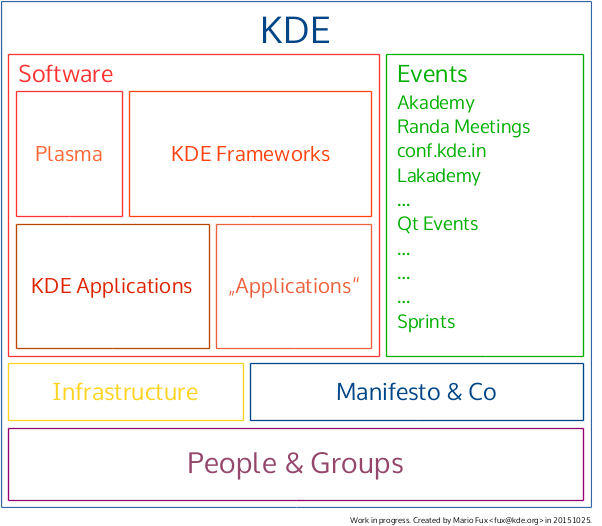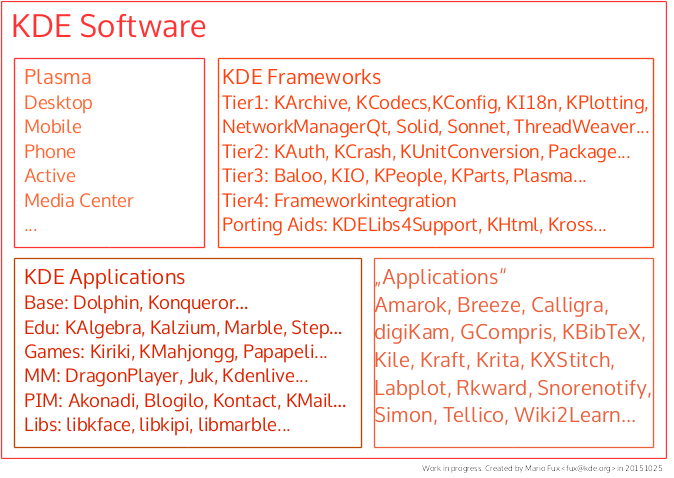So this is the first real blog post of the series My Wishion for KDE where I will write about my presonal view, wish and vision for KDE. This time the following questions will guide us or me: Where are we now? What is KDE currently?
But before I start – and below you’ll most probably find quite a long text – I’d like to include here a short summary that includes the most important thoughts and facts of the following wall of text. Though I highly recommend to not just read this summary but the whole article as there are many thoughts and ideas included (and even more not yet included) than the summary can handle.
Summary
KDE is mostly about people. We are a huge project with an almost 20 years old history. We’ve great infrastructure and values (Manifesto) and our software is targeted towards end-users and normal people. But do we really succeed and achieve what we want? Are there problems and what are they?
KDE is about people
KDE makes software – that we probably all know – but let’s first concentrate on the people of KDE. So KDE is the community and thus a rather big group of people (depicted as the foundation in the graphics below).

Estimations go as high as several thousand contributors world wide and several millions of users. But do we have some more concrete facts? When I posed a question about this to one of our system administration team members (thanks Ben) three days ago he delivered me the following numbers:
- 2320 active developer accounts
- 1167 disabled developer accounts
- 268,589 posts, comprised of 56,274 topics on the forum
Additionally we have several dozens of mailing lists which our besides the forums the most important internal communication channel. Another communication channel (Bugzilla on bugs.kde.org) which is currently the main channel to our users will get some more details in a moment.
KDE’s infrastructure
And there is even more infrastructure and services that KDE people use on a daily basis. E.g. the different wikis we use:
- Userbase provides information for end users on how to use KDE applications.
- Community provides a place for sharing information within the community.
- Techbase is for technical information about KDE software targeted at developers, ISVs and sysadmins.
For the synchronous communication (if it’s not a live meeting, see next paragraph) we use IRC, Jabber, Hangout, Jitsi, Telegram and Co.
So called real life (as if IRC and Co weren’t real life) or face-to-face events are depicted on the above graphics too. Akademy as the annual big KDE conference and community meeting and the Randa Meetings as the technical summit. Then there are the almost annual conf.kde.in – KDE conferences in India, Lakademy in Latin America and Akademy-fr and Akademy-es in France and Spain. And besides all this bigger events we see developer and contributor sprints that span from 2 to 4 days and from 2 to 20 people every other month.
KDE’s communication channels
And all the communication happening via these channels, on these events and through these media is governed through rules, guidelines, netiquettes and guared by common sense in KDE and our own Community Working Group. But probably the most important document we gave us is The KDE Manifesto which recordes our strong values like Free Software and End-User Focus and also defines the benefits and commitments of us and all our KDE projects.
KDE makes software
And thus we jump to the things that most people will connect with “KDE”: our software. Let’s zoom in to the software section of the overview picture above.

First some more information from the system adminstration side. We have:
- 837 mainline repositories
- 348,555 bugs [opened since 1996]
- 16 machines in total:
- 6 hosting core services
- 2 hosting anongit’s
- 4 hosting other various services
- and 4 machines powering the CI
Additionally (and this information is not from the precise sysadmins) our software consists of more than 5 million lines of code. And these lines of code don’t just consist of C++ and Qt code. No, you find in our repos as well C and GTK code, Javascript and Java, Bash and Python scripts, PHP projects and I’m sure I missed some projects. But where does this code run on? Mostly on GNU/Linux of course, but it runs on other free operating systems as well and on Windows, Android and MacOSX too. And we’re even exploring porting code to iOS (which is not easy and I don’t speak about the technological barriers) and probably even Windows Phone (does anybody know a KDE project there?). And at the end don’t forget some smaller mobile OSes like SailfishOS, UbuntuPhone and Blackberry.
KDE makes a variety of software
You might already know that it covers topics like Personal Information Management, games, education and multimedia, general internet stuff (whatevery that means), financial, sports and food topics, workspaces, design and artists themes, Office work, photo management and much much more.
And with this I’d like to take another look at the graphic I inserted above. There you see four areas of software we currently develop, create and release:
The last two sound a bit similar and that’s just a sign of bad naming (IMHO, but all I write here is my humble opinion). Interestingly enough for a certain definition of successful the most successful projects in KDE are part of “Applications” namely:
- Amarok – a powerful music player for Linux, Unix and Windows with an intuitive interface
- digiKam – Photo Management Program
- Krita – a FREE sketching and painting program
- Rkward – an easy to use and easily extensible IDE/GUI for R
All of them are released independently of the three big software collections we release in regular intervals.
KDE has very successful software projects
There are two other very successful pieces of software. One is Kdenlive – a free and open source video editor for GNU/Linux, Mac OS X and FreeBSD which is now part of the KDE Multimedia module which itself is part of the KDE Applications releases. The other is Plasma and probably currently mostly known for its desktop version and has its own release schedule.
But before I finish this first article I’d like to take a look at the less good sides of the KDE things. Shed some lights on more difficult or to-be-improved parts. I don’t want to dig deeper into these problems and I don’t want to propose solutions here and now (but soon). But I want you to think about these things as well.
KDE has problems too
Let’s take a look at a projects or community that once shared the office with us: Wikimedia Germany. There was even a time when our business manager worked half of the time for them. Today we don’t have a business manager anymore, the office is most of the time empty and Wikimedia occupies half a building in Berlin where they have several people working full-time on stuff for this great open knowledge and data projects. Another glimpse should be spend on our Sprint page. Just compare the number of sprints from recent years with this year… And then several people already talked, wrote and blogged about the decline of activity in our git repositories. So do we stagnate, decay or what is happening?
And there are some other problems or situations to consider:
- Hardware: We are now here and in the IT for almost 20 years and is some of our software somewhere pre-installed on everyday devices? Does anybody know of some? It should be as it’s good software but as far as I remember there was just some KDE software on Netbooks back when they were still sold with GNU/Linux…
- Software: Application Stores like the ones from Google, Apple, Amazon or even Microsoft are a dominant way how software is distributed today. And we’re still just starting to port some of our great software to Android…
- Money: Let’s compare us again with another free software organization: Mozilla. They can spend millions and what they offer is mostly a webbrowser. There were times when KDE offered at least three different webbrowsers and it’s still the case that the most widely used web rendering engine world wide has its origins in KDE. But we even fail to reach a fundraising goal of 40k…
Where is KDE’s future?
So we succeeded in the vision set 19 years ago, we’re still here and we’ve a lot of software and a great and welcoming community to offer. Currently we seem to be a bunch of projects creating and working on free end-user software that’s mostly based on Qt and running on GNU/Linux. But where should we go tomorrow, what should we target today, how should we define us and what’s the future of KDE? My personal vision, wishes and ideas for this can be read about in the next weeks part of “My wishion for KDE”… Read you then…

